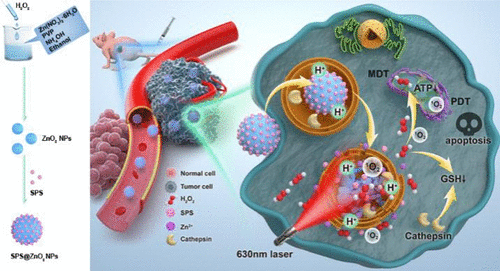当前位置:
X-MOL 学术
›
ACS Appl. Mater. Interfaces
›
论文详情
Our official English website, www.x-mol.net, welcomes your
feedback! (Note: you will need to create a separate account there.)
Tumor Microenvironment-Responsive Theranostic Nanoplatform for Guided Molecular Dynamic/Photodynamic Synergistic Therapy
ACS Applied Materials & Interfaces ( IF 8.3 ) Pub Date : 2021-04-08 , DOI: 10.1021/acsami.1c03277 Dong-Yang Zhang 1, 2 , Fanglin Huang 1 , Yan Ma 1 , Guangzhong Liang 1 , Zhuo Peng 1 , Shixia Guan 1 , Junqiu Zhai 1
ACS Applied Materials & Interfaces ( IF 8.3 ) Pub Date : 2021-04-08 , DOI: 10.1021/acsami.1c03277 Dong-Yang Zhang 1, 2 , Fanglin Huang 1 , Yan Ma 1 , Guangzhong Liang 1 , Zhuo Peng 1 , Shixia Guan 1 , Junqiu Zhai 1
Affiliation

|
The integration of reactive oxygen species (ROS)-involved molecular dynamic therapy (MDT) and photodynamic therapy (PDT) holds great promise for enhanced anticancer effects. Herein, we report a biodegradable tumor microenvironment-responsive nanoplatform composed of sinoporphyrin sodium (SPS) photosensitizer-loaded zinc peroxide nanoparticles (SPS@ZnO2 NPs), which can enhance the action of ROS through the production of hydrogen peroxide (H2O2) and singlet oxygen (1O2) for MDT and PDT, respectively, and the depletion of glutathione (GSH). Under these conditions, SPS@ZnO2 NPs show excellent MDT/PDT synergistic therapeutic effects. We demonstrate that the SPS@ZnO2 NPs quickly degrade to H2O2 and endogenous Zn2+ in an acidic tumor environment and produce toxic 1O2 with 630 nm laser irradiation both in vitro and in vivo. Anticancer mechanistic studies show that excessive production of ROS damages lysosomes and mitochondria and induces cellular apoptosis. We show that SPS@ZnO2 NPs increase the uptake and penetration depth of photosensitizers in cells. In addition, the fluorescence of SPS is a powerful diagnostic tool for the treatment of tumors. The depletion of intracellular GSH through H2O2 production and the release of cathepsin B enhance the effectiveness of PDT. This theranostic nanoplatform provides a new avenue for tumor microenvironment-responsive and ROS-involved therapeutic strategies with synergistic enhancement of antitumor activity.
中文翻译:

肿瘤微环境响应治疗学纳米平台用于分子动态/光动力协同治疗的指导。
涉及活性氧(ROS)的分子动力学疗法(MDT)和光动力学疗法(PDT)的整合具有增强抗癌作用的巨大希望。本文中,我们报道了由卟啉钠(SPS)光敏剂负载的过氧化锌纳米粒子(SPS @ ZnO 2 NPs)组成的可生物降解的肿瘤微环境响应纳米平台,该平台可通过产生过氧化氢(H 2 O 2)增强ROS的作用。)和单线态氧(1 O 2)分别用于MDT和PDT,以及消耗谷胱甘肽(GSH)。在这些条件下,SPS @ ZnO 2 NPs显示出优异的MDT / PDT协同治疗效果。我们证明了SPS @ ZnO 2的NP迅速降解成H 2 ö 2和内源性的Zn 2+在酸性肿瘤环境中和产生有毒1 ö 2与两个630nm的激光照射在体外和体内。抗癌机理研究表明,过量产生ROS会破坏溶酶体和线粒体并诱导细胞凋亡。我们表明,SPS @ ZnO 2 NPs增加了光敏剂在细胞中的吸收和渗透深度。此外,SPS的荧光是用于治疗肿瘤的强大诊断工具。通过H 2 O 2消耗细胞内GSH组织蛋白酶B的产生和释放增强了PDT的效力。这种治疗上的纳米平台为肿瘤微环境响应和ROS参与的治疗策略提供了新途径,并协同增强了抗肿瘤活性。
更新日期:2021-04-21
中文翻译:

肿瘤微环境响应治疗学纳米平台用于分子动态/光动力协同治疗的指导。
涉及活性氧(ROS)的分子动力学疗法(MDT)和光动力学疗法(PDT)的整合具有增强抗癌作用的巨大希望。本文中,我们报道了由卟啉钠(SPS)光敏剂负载的过氧化锌纳米粒子(SPS @ ZnO 2 NPs)组成的可生物降解的肿瘤微环境响应纳米平台,该平台可通过产生过氧化氢(H 2 O 2)增强ROS的作用。)和单线态氧(1 O 2)分别用于MDT和PDT,以及消耗谷胱甘肽(GSH)。在这些条件下,SPS @ ZnO 2 NPs显示出优异的MDT / PDT协同治疗效果。我们证明了SPS @ ZnO 2的NP迅速降解成H 2 ö 2和内源性的Zn 2+在酸性肿瘤环境中和产生有毒1 ö 2与两个630nm的激光照射在体外和体内。抗癌机理研究表明,过量产生ROS会破坏溶酶体和线粒体并诱导细胞凋亡。我们表明,SPS @ ZnO 2 NPs增加了光敏剂在细胞中的吸收和渗透深度。此外,SPS的荧光是用于治疗肿瘤的强大诊断工具。通过H 2 O 2消耗细胞内GSH组织蛋白酶B的产生和释放增强了PDT的效力。这种治疗上的纳米平台为肿瘤微环境响应和ROS参与的治疗策略提供了新途径,并协同增强了抗肿瘤活性。































 京公网安备 11010802027423号
京公网安备 11010802027423号